Corporate Finance: A Detailed Report on Capital Budgeting Techniques
VerifiedAdded on 2019/10/31
|12
|2750
|290
Report
AI Summary
This report provides a detailed overview of capital budgeting techniques used in corporate finance. It begins with an introduction to capital budgeting and its importance in organizational management, highlighting its role in evaluating long-term risks and reducing operational costs. The report then delves into specific techniques, including sensitivity analysis, which assesses the impact of crucial variables on net profits; break-even analysis, used to determine the point at which profits equal costs; scenario analysis, a strategic tool for analyzing decisions under various potential outcomes; and simulation techniques, which utilize numerical data to model the standard outcome of scenario analysis. Each technique is explained with its advantages and limitations, providing managers with a comprehensive understanding to aid in decision-making for new ventures and project evaluations. The report concludes by emphasizing the importance of these tools in reducing risks and reevaluating investment decisions, offering a platform for informed strategic planning.
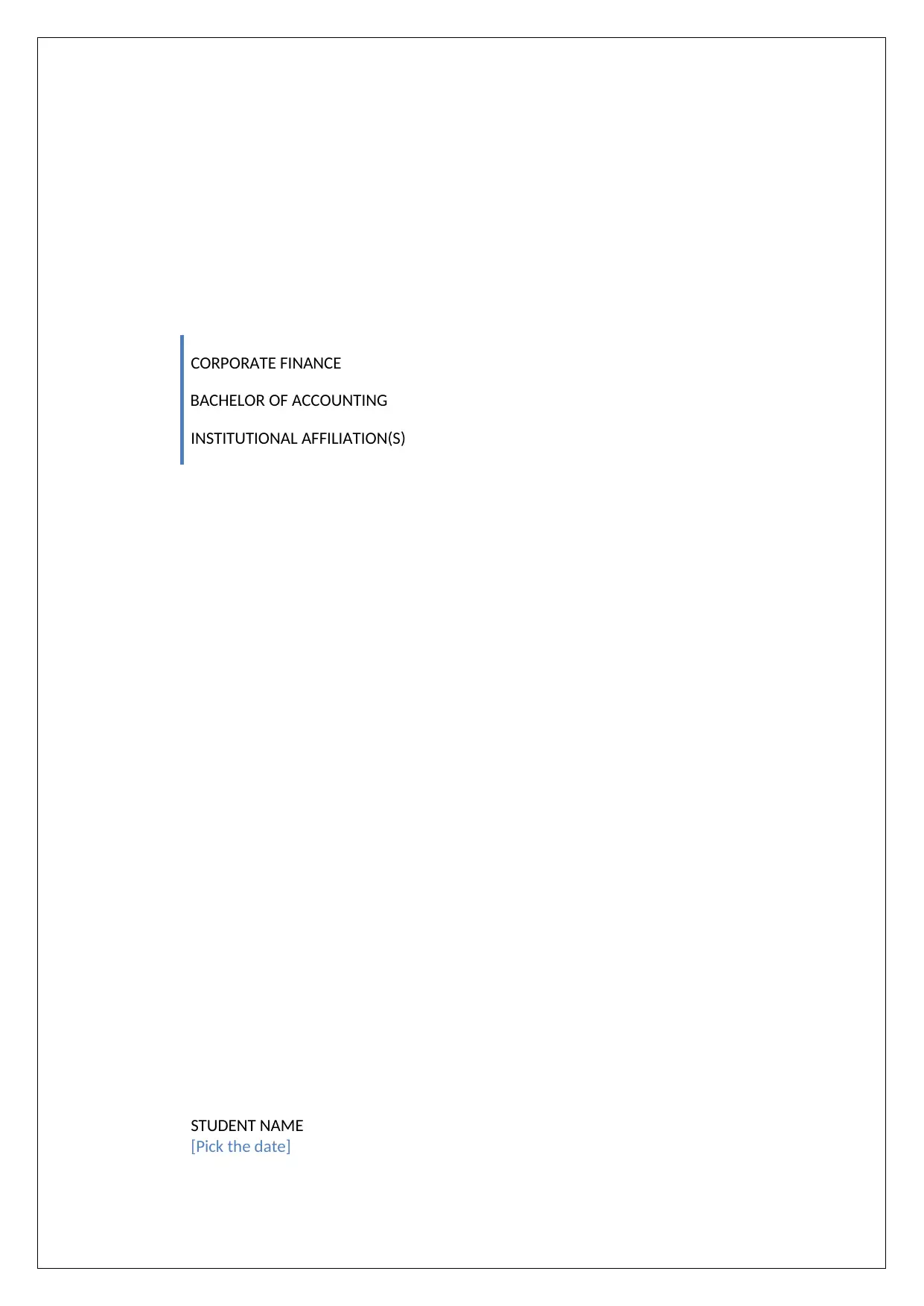
CORPORATE FINANCE
BACHELOR OF ACCOUNTING
INSTITUTIONAL AFFILIATION(S)
STUDENT NAME
[Pick the date]
BACHELOR OF ACCOUNTING
INSTITUTIONAL AFFILIATION(S)
STUDENT NAME
[Pick the date]
Paraphrase This Document
Need a fresh take? Get an instant paraphrase of this document with our AI Paraphraser
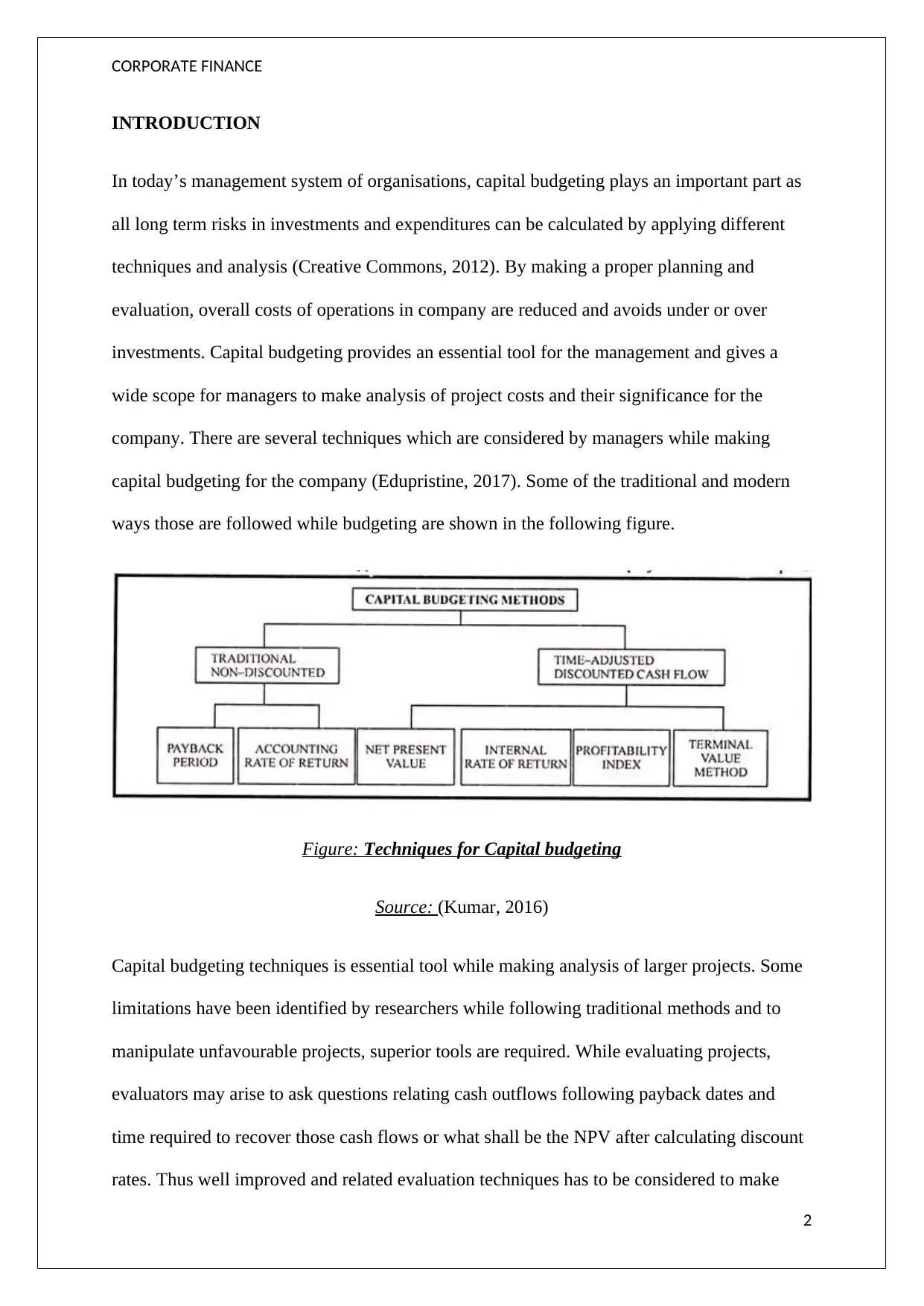
CORPORATE FINANCE
INTRODUCTION
In today’s management system of organisations, capital budgeting plays an important part as
all long term risks in investments and expenditures can be calculated by applying different
techniques and analysis (Creative Commons, 2012). By making a proper planning and
evaluation, overall costs of operations in company are reduced and avoids under or over
investments. Capital budgeting provides an essential tool for the management and gives a
wide scope for managers to make analysis of project costs and their significance for the
company. There are several techniques which are considered by managers while making
capital budgeting for the company (Edupristine, 2017). Some of the traditional and modern
ways those are followed while budgeting are shown in the following figure.
Figure: Techniques for Capital budgeting
Source: (Kumar, 2016)
Capital budgeting techniques is essential tool while making analysis of larger projects. Some
limitations have been identified by researchers while following traditional methods and to
manipulate unfavourable projects, superior tools are required. While evaluating projects,
evaluators may arise to ask questions relating cash outflows following payback dates and
time required to recover those cash flows or what shall be the NPV after calculating discount
rates. Thus well improved and related evaluation techniques has to be considered to make
2
INTRODUCTION
In today’s management system of organisations, capital budgeting plays an important part as
all long term risks in investments and expenditures can be calculated by applying different
techniques and analysis (Creative Commons, 2012). By making a proper planning and
evaluation, overall costs of operations in company are reduced and avoids under or over
investments. Capital budgeting provides an essential tool for the management and gives a
wide scope for managers to make analysis of project costs and their significance for the
company. There are several techniques which are considered by managers while making
capital budgeting for the company (Edupristine, 2017). Some of the traditional and modern
ways those are followed while budgeting are shown in the following figure.
Figure: Techniques for Capital budgeting
Source: (Kumar, 2016)
Capital budgeting techniques is essential tool while making analysis of larger projects. Some
limitations have been identified by researchers while following traditional methods and to
manipulate unfavourable projects, superior tools are required. While evaluating projects,
evaluators may arise to ask questions relating cash outflows following payback dates and
time required to recover those cash flows or what shall be the NPV after calculating discount
rates. Thus well improved and related evaluation techniques has to be considered to make
2
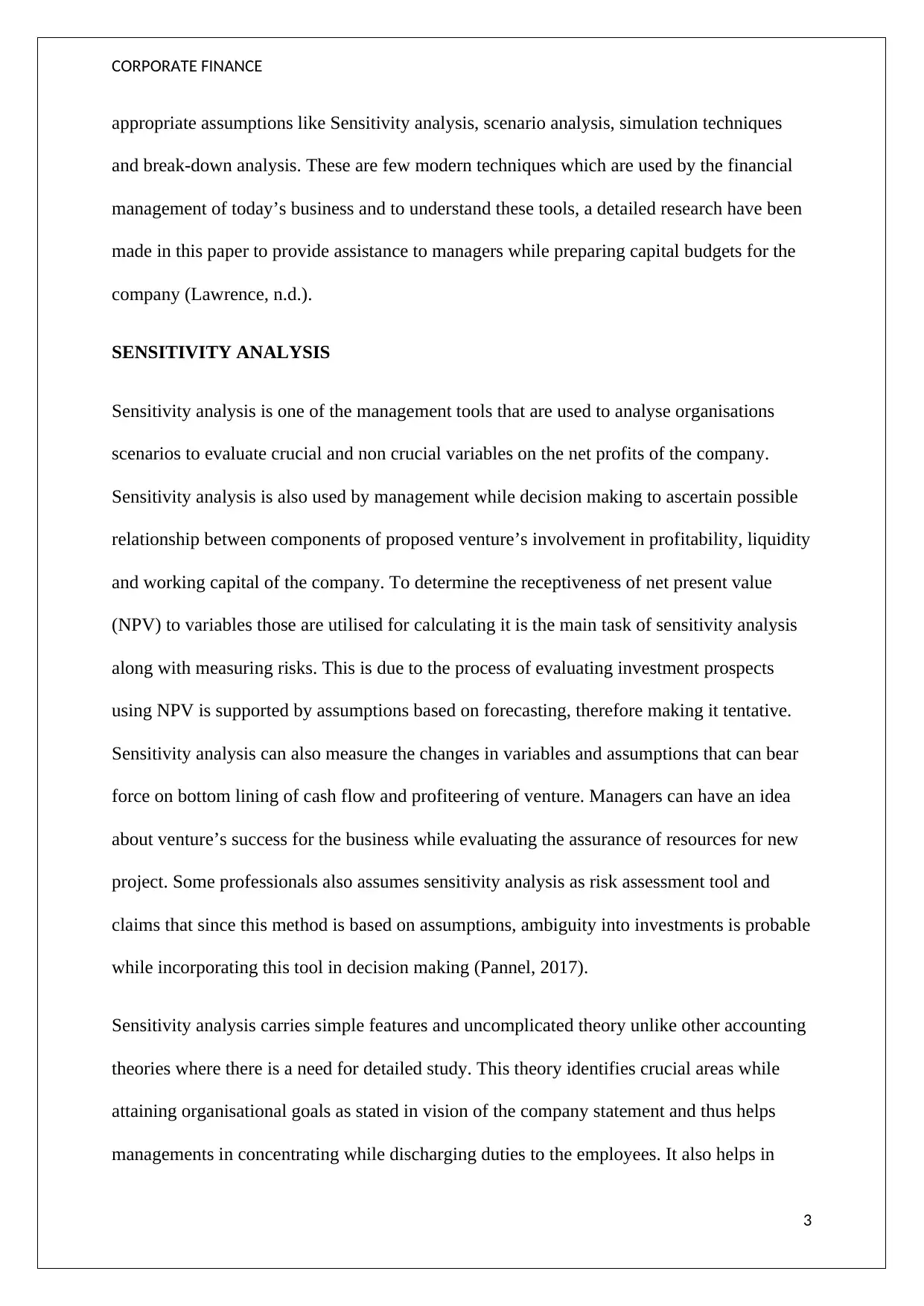
CORPORATE FINANCE
appropriate assumptions like Sensitivity analysis, scenario analysis, simulation techniques
and break-down analysis. These are few modern techniques which are used by the financial
management of today’s business and to understand these tools, a detailed research have been
made in this paper to provide assistance to managers while preparing capital budgets for the
company (Lawrence, n.d.).
SENSITIVITY ANALYSIS
Sensitivity analysis is one of the management tools that are used to analyse organisations
scenarios to evaluate crucial and non crucial variables on the net profits of the company.
Sensitivity analysis is also used by management while decision making to ascertain possible
relationship between components of proposed venture’s involvement in profitability, liquidity
and working capital of the company. To determine the receptiveness of net present value
(NPV) to variables those are utilised for calculating it is the main task of sensitivity analysis
along with measuring risks. This is due to the process of evaluating investment prospects
using NPV is supported by assumptions based on forecasting, therefore making it tentative.
Sensitivity analysis can also measure the changes in variables and assumptions that can bear
force on bottom lining of cash flow and profiteering of venture. Managers can have an idea
about venture’s success for the business while evaluating the assurance of resources for new
project. Some professionals also assumes sensitivity analysis as risk assessment tool and
claims that since this method is based on assumptions, ambiguity into investments is probable
while incorporating this tool in decision making (Pannel, 2017).
Sensitivity analysis carries simple features and uncomplicated theory unlike other accounting
theories where there is a need for detailed study. This theory identifies crucial areas while
attaining organisational goals as stated in vision of the company statement and thus helps
managements in concentrating while discharging duties to the employees. It also helps in
3
appropriate assumptions like Sensitivity analysis, scenario analysis, simulation techniques
and break-down analysis. These are few modern techniques which are used by the financial
management of today’s business and to understand these tools, a detailed research have been
made in this paper to provide assistance to managers while preparing capital budgets for the
company (Lawrence, n.d.).
SENSITIVITY ANALYSIS
Sensitivity analysis is one of the management tools that are used to analyse organisations
scenarios to evaluate crucial and non crucial variables on the net profits of the company.
Sensitivity analysis is also used by management while decision making to ascertain possible
relationship between components of proposed venture’s involvement in profitability, liquidity
and working capital of the company. To determine the receptiveness of net present value
(NPV) to variables those are utilised for calculating it is the main task of sensitivity analysis
along with measuring risks. This is due to the process of evaluating investment prospects
using NPV is supported by assumptions based on forecasting, therefore making it tentative.
Sensitivity analysis can also measure the changes in variables and assumptions that can bear
force on bottom lining of cash flow and profiteering of venture. Managers can have an idea
about venture’s success for the business while evaluating the assurance of resources for new
project. Some professionals also assumes sensitivity analysis as risk assessment tool and
claims that since this method is based on assumptions, ambiguity into investments is probable
while incorporating this tool in decision making (Pannel, 2017).
Sensitivity analysis carries simple features and uncomplicated theory unlike other accounting
theories where there is a need for detailed study. This theory identifies crucial areas while
attaining organisational goals as stated in vision of the company statement and thus helps
managements in concentrating while discharging duties to the employees. It also helps in
3
⊘ This is a preview!⊘
Do you want full access?
Subscribe today to unlock all pages.

Trusted by 1+ million students worldwide
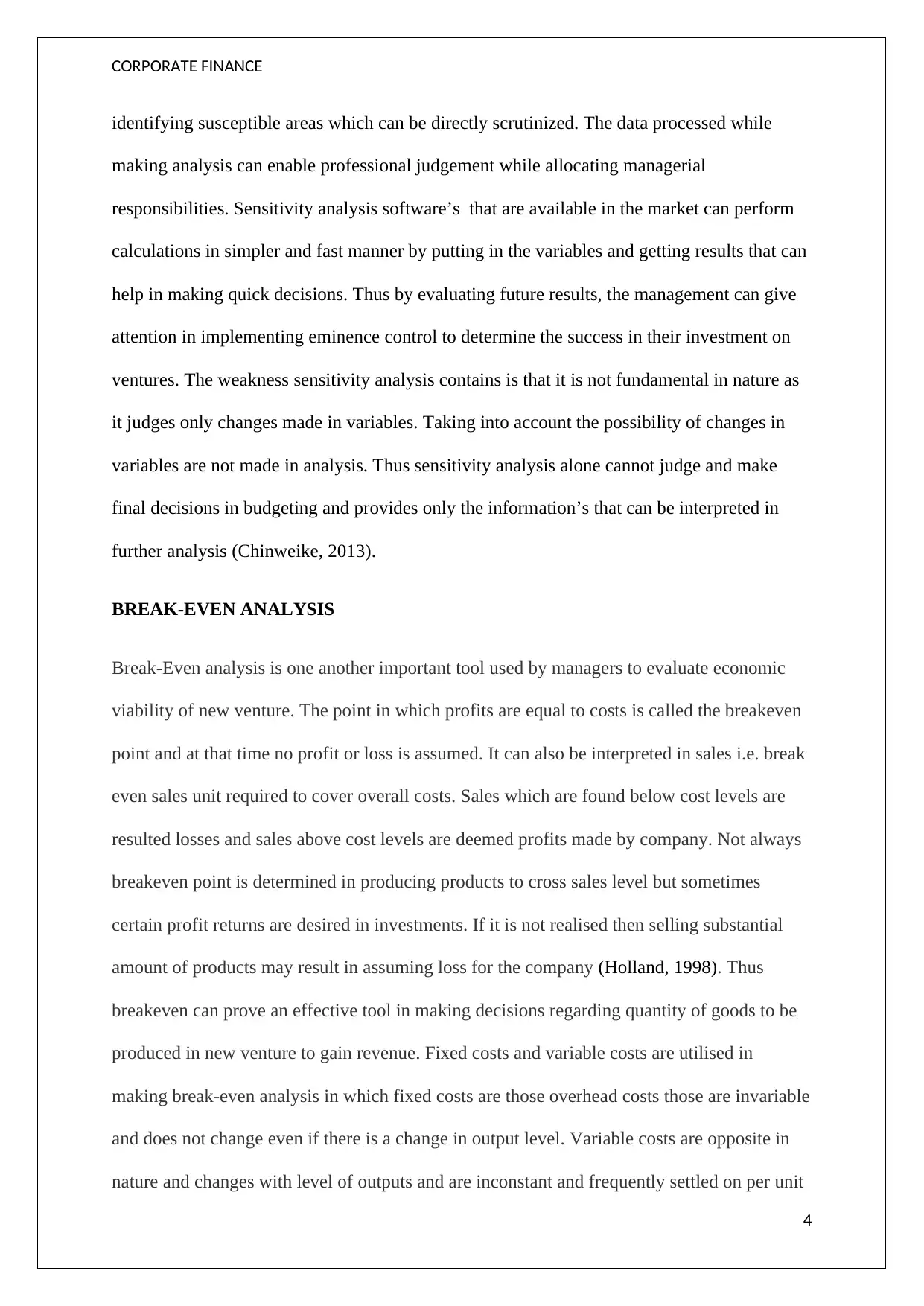
CORPORATE FINANCE
identifying susceptible areas which can be directly scrutinized. The data processed while
making analysis can enable professional judgement while allocating managerial
responsibilities. Sensitivity analysis software’s that are available in the market can perform
calculations in simpler and fast manner by putting in the variables and getting results that can
help in making quick decisions. Thus by evaluating future results, the management can give
attention in implementing eminence control to determine the success in their investment on
ventures. The weakness sensitivity analysis contains is that it is not fundamental in nature as
it judges only changes made in variables. Taking into account the possibility of changes in
variables are not made in analysis. Thus sensitivity analysis alone cannot judge and make
final decisions in budgeting and provides only the information’s that can be interpreted in
further analysis (Chinweike, 2013).
BREAK-EVEN ANALYSIS
Break-Even analysis is one another important tool used by managers to evaluate economic
viability of new venture. The point in which profits are equal to costs is called the breakeven
point and at that time no profit or loss is assumed. It can also be interpreted in sales i.e. break
even sales unit required to cover overall costs. Sales which are found below cost levels are
resulted losses and sales above cost levels are deemed profits made by company. Not always
breakeven point is determined in producing products to cross sales level but sometimes
certain profit returns are desired in investments. If it is not realised then selling substantial
amount of products may result in assuming loss for the company (Holland, 1998). Thus
breakeven can prove an effective tool in making decisions regarding quantity of goods to be
produced in new venture to gain revenue. Fixed costs and variable costs are utilised in
making break-even analysis in which fixed costs are those overhead costs those are invariable
and does not change even if there is a change in output level. Variable costs are opposite in
nature and changes with level of outputs and are inconstant and frequently settled on per unit
4
identifying susceptible areas which can be directly scrutinized. The data processed while
making analysis can enable professional judgement while allocating managerial
responsibilities. Sensitivity analysis software’s that are available in the market can perform
calculations in simpler and fast manner by putting in the variables and getting results that can
help in making quick decisions. Thus by evaluating future results, the management can give
attention in implementing eminence control to determine the success in their investment on
ventures. The weakness sensitivity analysis contains is that it is not fundamental in nature as
it judges only changes made in variables. Taking into account the possibility of changes in
variables are not made in analysis. Thus sensitivity analysis alone cannot judge and make
final decisions in budgeting and provides only the information’s that can be interpreted in
further analysis (Chinweike, 2013).
BREAK-EVEN ANALYSIS
Break-Even analysis is one another important tool used by managers to evaluate economic
viability of new venture. The point in which profits are equal to costs is called the breakeven
point and at that time no profit or loss is assumed. It can also be interpreted in sales i.e. break
even sales unit required to cover overall costs. Sales which are found below cost levels are
resulted losses and sales above cost levels are deemed profits made by company. Not always
breakeven point is determined in producing products to cross sales level but sometimes
certain profit returns are desired in investments. If it is not realised then selling substantial
amount of products may result in assuming loss for the company (Holland, 1998). Thus
breakeven can prove an effective tool in making decisions regarding quantity of goods to be
produced in new venture to gain revenue. Fixed costs and variable costs are utilised in
making break-even analysis in which fixed costs are those overhead costs those are invariable
and does not change even if there is a change in output level. Variable costs are opposite in
nature and changes with level of outputs and are inconstant and frequently settled on per unit
4
Paraphrase This Document
Need a fresh take? Get an instant paraphrase of this document with our AI Paraphraser
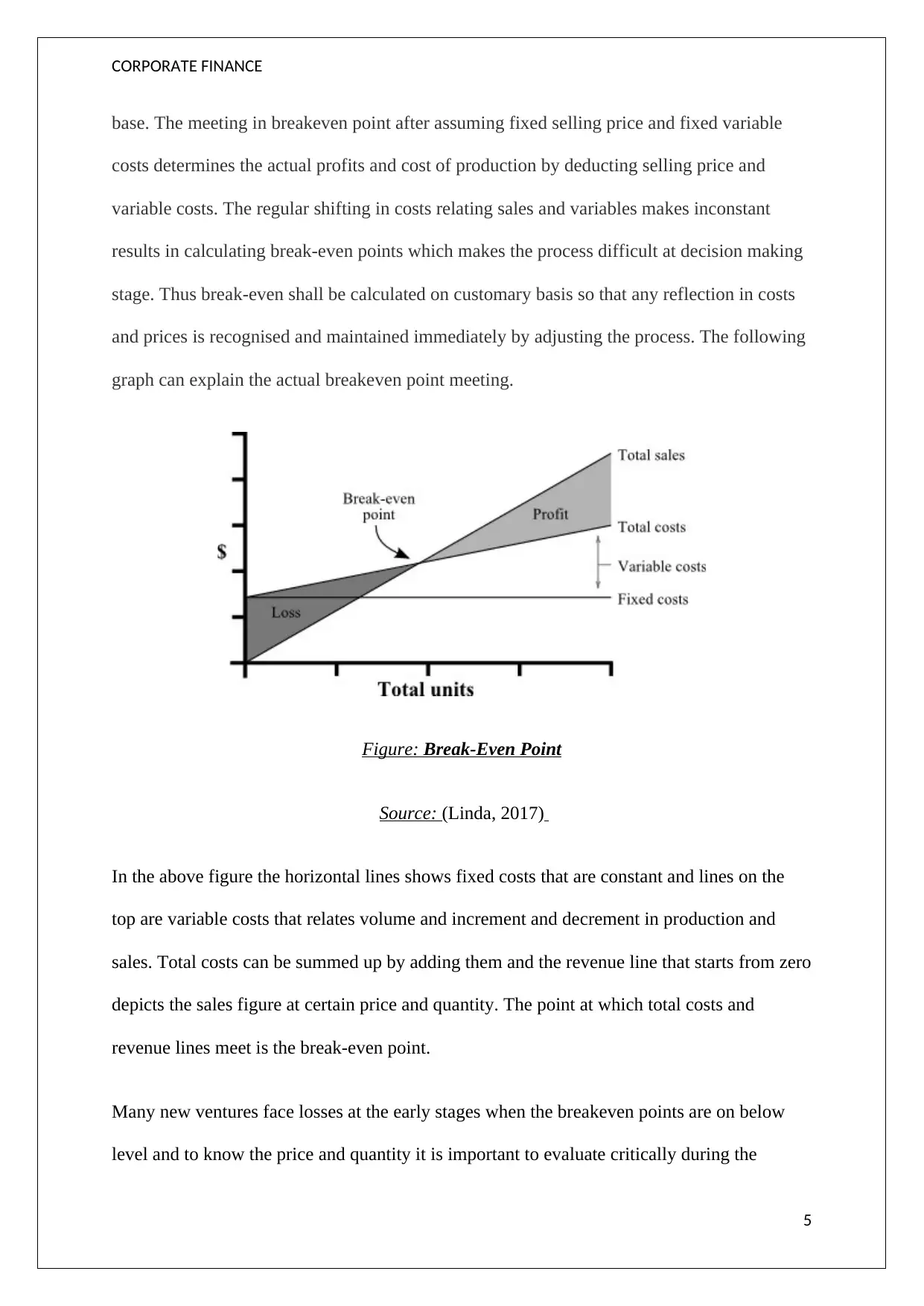
CORPORATE FINANCE
base. The meeting in breakeven point after assuming fixed selling price and fixed variable
costs determines the actual profits and cost of production by deducting selling price and
variable costs. The regular shifting in costs relating sales and variables makes inconstant
results in calculating break-even points which makes the process difficult at decision making
stage. Thus break-even shall be calculated on customary basis so that any reflection in costs
and prices is recognised and maintained immediately by adjusting the process. The following
graph can explain the actual breakeven point meeting.
Figure: Break-Even Point
Source: (Linda, 2017)
In the above figure the horizontal lines shows fixed costs that are constant and lines on the
top are variable costs that relates volume and increment and decrement in production and
sales. Total costs can be summed up by adding them and the revenue line that starts from zero
depicts the sales figure at certain price and quantity. The point at which total costs and
revenue lines meet is the break-even point.
Many new ventures face losses at the early stages when the breakeven points are on below
level and to know the price and quantity it is important to evaluate critically during the
5
base. The meeting in breakeven point after assuming fixed selling price and fixed variable
costs determines the actual profits and cost of production by deducting selling price and
variable costs. The regular shifting in costs relating sales and variables makes inconstant
results in calculating break-even points which makes the process difficult at decision making
stage. Thus break-even shall be calculated on customary basis so that any reflection in costs
and prices is recognised and maintained immediately by adjusting the process. The following
graph can explain the actual breakeven point meeting.
Figure: Break-Even Point
Source: (Linda, 2017)
In the above figure the horizontal lines shows fixed costs that are constant and lines on the
top are variable costs that relates volume and increment and decrement in production and
sales. Total costs can be summed up by adding them and the revenue line that starts from zero
depicts the sales figure at certain price and quantity. The point at which total costs and
revenue lines meet is the break-even point.
Many new ventures face losses at the early stages when the breakeven points are on below
level and to know the price and quantity it is important to evaluate critically during the
5
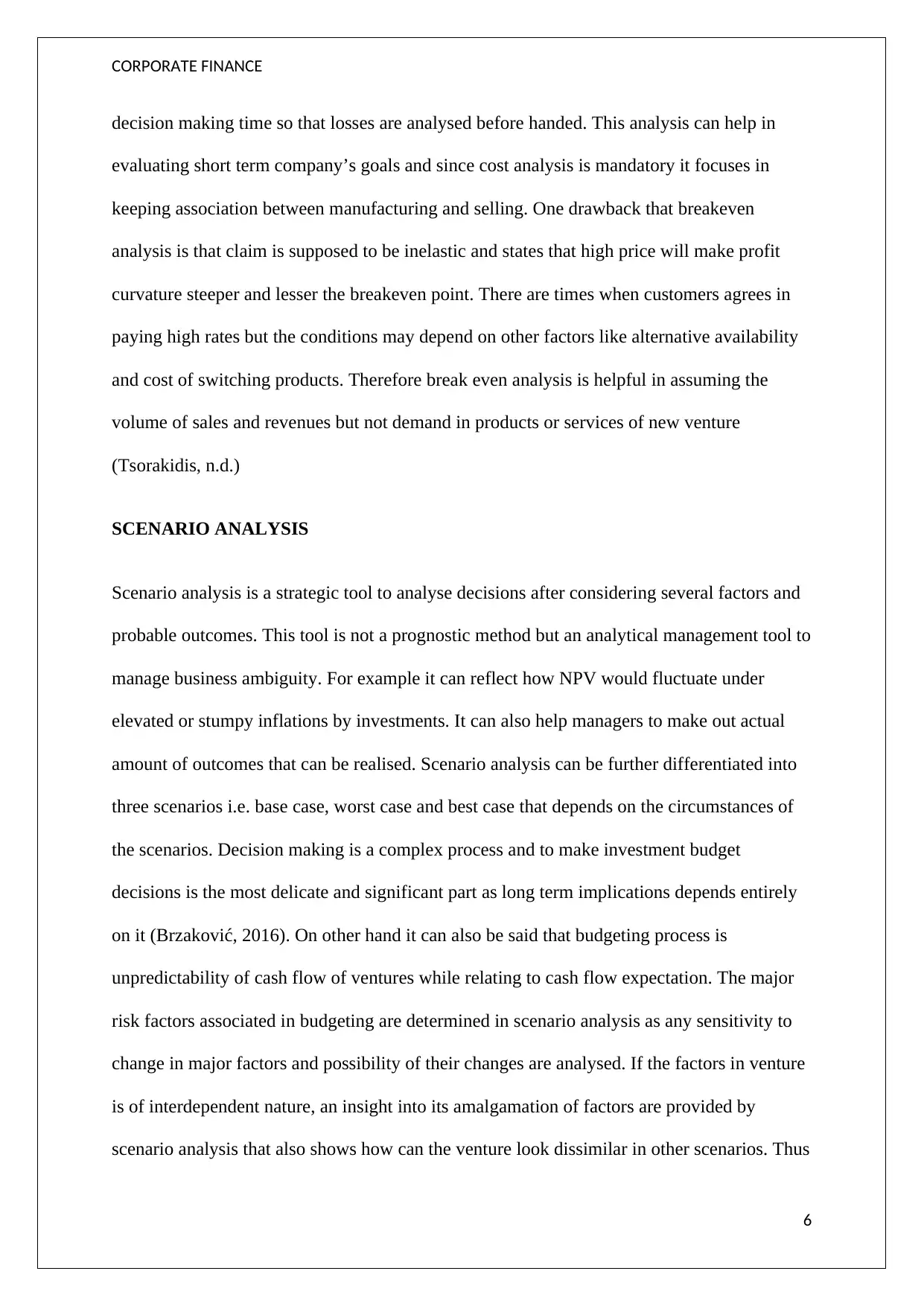
CORPORATE FINANCE
decision making time so that losses are analysed before handed. This analysis can help in
evaluating short term company’s goals and since cost analysis is mandatory it focuses in
keeping association between manufacturing and selling. One drawback that breakeven
analysis is that claim is supposed to be inelastic and states that high price will make profit
curvature steeper and lesser the breakeven point. There are times when customers agrees in
paying high rates but the conditions may depend on other factors like alternative availability
and cost of switching products. Therefore break even analysis is helpful in assuming the
volume of sales and revenues but not demand in products or services of new venture
(Tsorakidis, n.d.)
SCENARIO ANALYSIS
Scenario analysis is a strategic tool to analyse decisions after considering several factors and
probable outcomes. This tool is not a prognostic method but an analytical management tool to
manage business ambiguity. For example it can reflect how NPV would fluctuate under
elevated or stumpy inflations by investments. It can also help managers to make out actual
amount of outcomes that can be realised. Scenario analysis can be further differentiated into
three scenarios i.e. base case, worst case and best case that depends on the circumstances of
the scenarios. Decision making is a complex process and to make investment budget
decisions is the most delicate and significant part as long term implications depends entirely
on it (Brzaković, 2016). On other hand it can also be said that budgeting process is
unpredictability of cash flow of ventures while relating to cash flow expectation. The major
risk factors associated in budgeting are determined in scenario analysis as any sensitivity to
change in major factors and possibility of their changes are analysed. If the factors in venture
is of interdependent nature, an insight into its amalgamation of factors are provided by
scenario analysis that also shows how can the venture look dissimilar in other scenarios. Thus
6
decision making time so that losses are analysed before handed. This analysis can help in
evaluating short term company’s goals and since cost analysis is mandatory it focuses in
keeping association between manufacturing and selling. One drawback that breakeven
analysis is that claim is supposed to be inelastic and states that high price will make profit
curvature steeper and lesser the breakeven point. There are times when customers agrees in
paying high rates but the conditions may depend on other factors like alternative availability
and cost of switching products. Therefore break even analysis is helpful in assuming the
volume of sales and revenues but not demand in products or services of new venture
(Tsorakidis, n.d.)
SCENARIO ANALYSIS
Scenario analysis is a strategic tool to analyse decisions after considering several factors and
probable outcomes. This tool is not a prognostic method but an analytical management tool to
manage business ambiguity. For example it can reflect how NPV would fluctuate under
elevated or stumpy inflations by investments. It can also help managers to make out actual
amount of outcomes that can be realised. Scenario analysis can be further differentiated into
three scenarios i.e. base case, worst case and best case that depends on the circumstances of
the scenarios. Decision making is a complex process and to make investment budget
decisions is the most delicate and significant part as long term implications depends entirely
on it (Brzaković, 2016). On other hand it can also be said that budgeting process is
unpredictability of cash flow of ventures while relating to cash flow expectation. The major
risk factors associated in budgeting are determined in scenario analysis as any sensitivity to
change in major factors and possibility of their changes are analysed. If the factors in venture
is of interdependent nature, an insight into its amalgamation of factors are provided by
scenario analysis that also shows how can the venture look dissimilar in other scenarios. Thus
6
⊘ This is a preview!⊘
Do you want full access?
Subscribe today to unlock all pages.

Trusted by 1+ million students worldwide
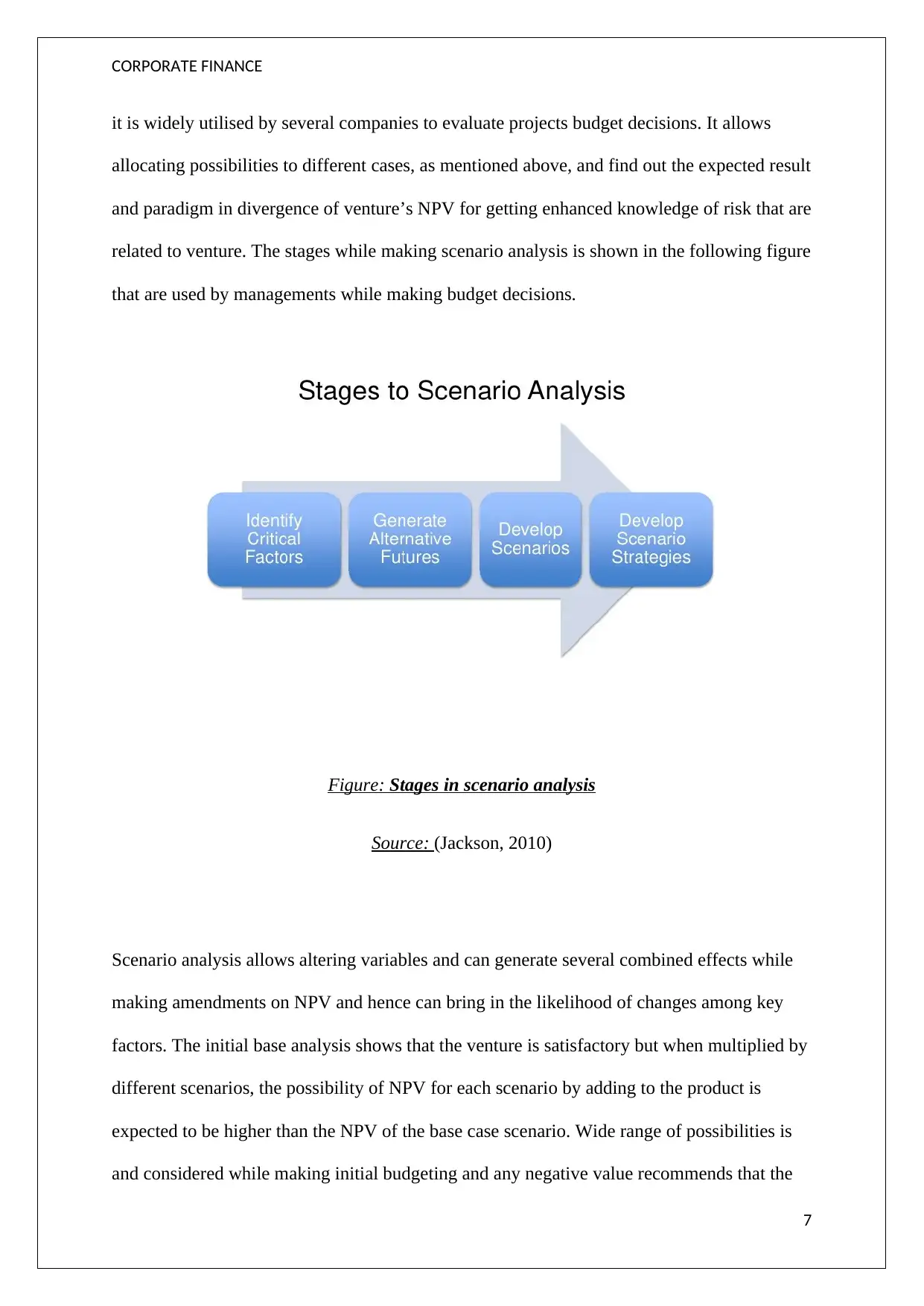
CORPORATE FINANCE
it is widely utilised by several companies to evaluate projects budget decisions. It allows
allocating possibilities to different cases, as mentioned above, and find out the expected result
and paradigm in divergence of venture’s NPV for getting enhanced knowledge of risk that are
related to venture. The stages while making scenario analysis is shown in the following figure
that are used by managements while making budget decisions.
Figure: Stages in scenario analysis
Source: (Jackson, 2010)
Scenario analysis allows altering variables and can generate several combined effects while
making amendments on NPV and hence can bring in the likelihood of changes among key
factors. The initial base analysis shows that the venture is satisfactory but when multiplied by
different scenarios, the possibility of NPV for each scenario by adding to the product is
expected to be higher than the NPV of the base case scenario. Wide range of possibilities is
and considered while making initial budgeting and any negative value recommends that the
7
it is widely utilised by several companies to evaluate projects budget decisions. It allows
allocating possibilities to different cases, as mentioned above, and find out the expected result
and paradigm in divergence of venture’s NPV for getting enhanced knowledge of risk that are
related to venture. The stages while making scenario analysis is shown in the following figure
that are used by managements while making budget decisions.
Figure: Stages in scenario analysis
Source: (Jackson, 2010)
Scenario analysis allows altering variables and can generate several combined effects while
making amendments on NPV and hence can bring in the likelihood of changes among key
factors. The initial base analysis shows that the venture is satisfactory but when multiplied by
different scenarios, the possibility of NPV for each scenario by adding to the product is
expected to be higher than the NPV of the base case scenario. Wide range of possibilities is
and considered while making initial budgeting and any negative value recommends that the
7
Paraphrase This Document
Need a fresh take? Get an instant paraphrase of this document with our AI Paraphraser
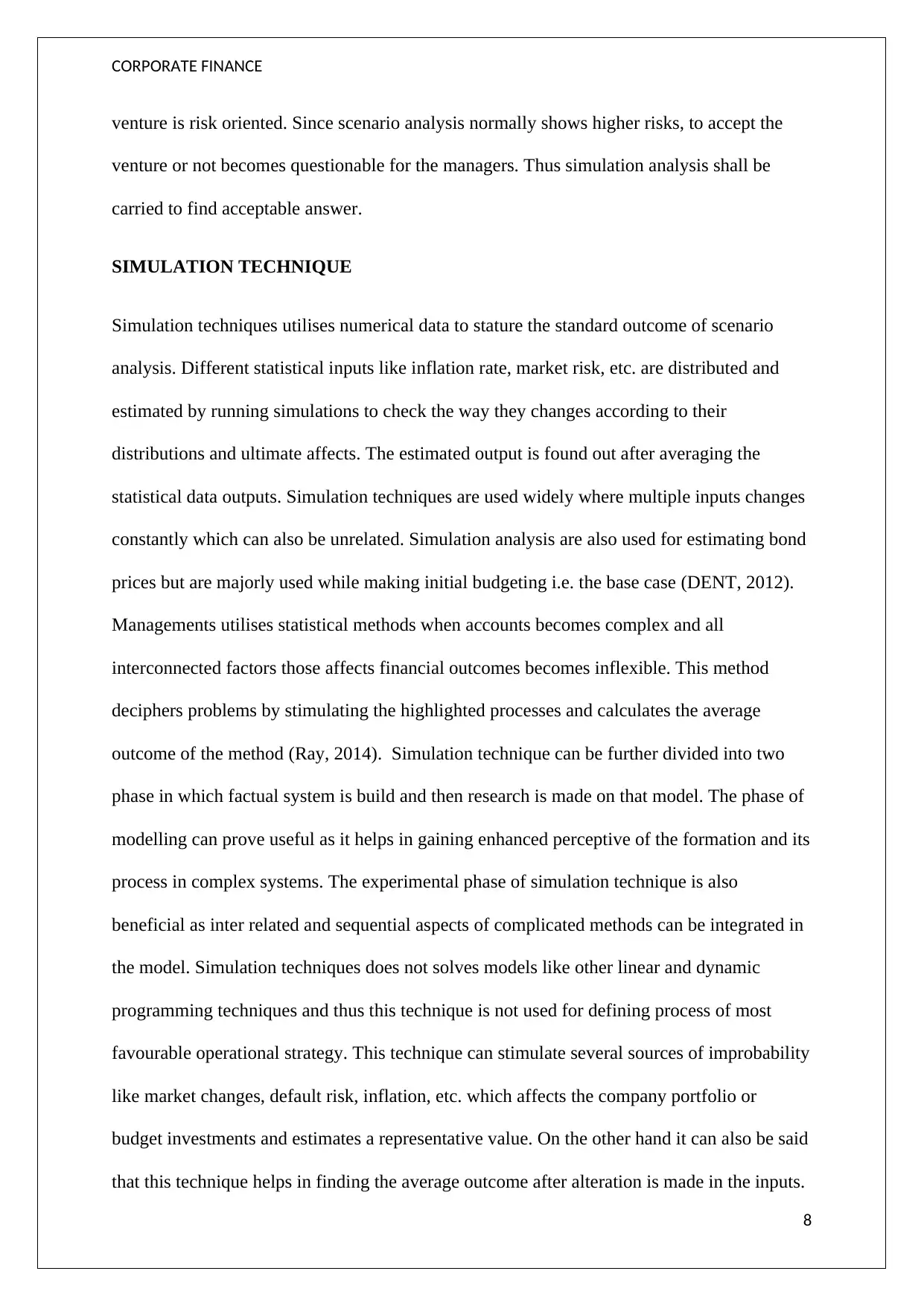
CORPORATE FINANCE
venture is risk oriented. Since scenario analysis normally shows higher risks, to accept the
venture or not becomes questionable for the managers. Thus simulation analysis shall be
carried to find acceptable answer.
SIMULATION TECHNIQUE
Simulation techniques utilises numerical data to stature the standard outcome of scenario
analysis. Different statistical inputs like inflation rate, market risk, etc. are distributed and
estimated by running simulations to check the way they changes according to their
distributions and ultimate affects. The estimated output is found out after averaging the
statistical data outputs. Simulation techniques are used widely where multiple inputs changes
constantly which can also be unrelated. Simulation analysis are also used for estimating bond
prices but are majorly used while making initial budgeting i.e. the base case (DENT, 2012).
Managements utilises statistical methods when accounts becomes complex and all
interconnected factors those affects financial outcomes becomes inflexible. This method
deciphers problems by stimulating the highlighted processes and calculates the average
outcome of the method (Ray, 2014). Simulation technique can be further divided into two
phase in which factual system is build and then research is made on that model. The phase of
modelling can prove useful as it helps in gaining enhanced perceptive of the formation and its
process in complex systems. The experimental phase of simulation technique is also
beneficial as inter related and sequential aspects of complicated methods can be integrated in
the model. Simulation techniques does not solves models like other linear and dynamic
programming techniques and thus this technique is not used for defining process of most
favourable operational strategy. This technique can stimulate several sources of improbability
like market changes, default risk, inflation, etc. which affects the company portfolio or
budget investments and estimates a representative value. On the other hand it can also be said
that this technique helps in finding the average outcome after alteration is made in the inputs.
8
venture is risk oriented. Since scenario analysis normally shows higher risks, to accept the
venture or not becomes questionable for the managers. Thus simulation analysis shall be
carried to find acceptable answer.
SIMULATION TECHNIQUE
Simulation techniques utilises numerical data to stature the standard outcome of scenario
analysis. Different statistical inputs like inflation rate, market risk, etc. are distributed and
estimated by running simulations to check the way they changes according to their
distributions and ultimate affects. The estimated output is found out after averaging the
statistical data outputs. Simulation techniques are used widely where multiple inputs changes
constantly which can also be unrelated. Simulation analysis are also used for estimating bond
prices but are majorly used while making initial budgeting i.e. the base case (DENT, 2012).
Managements utilises statistical methods when accounts becomes complex and all
interconnected factors those affects financial outcomes becomes inflexible. This method
deciphers problems by stimulating the highlighted processes and calculates the average
outcome of the method (Ray, 2014). Simulation technique can be further divided into two
phase in which factual system is build and then research is made on that model. The phase of
modelling can prove useful as it helps in gaining enhanced perceptive of the formation and its
process in complex systems. The experimental phase of simulation technique is also
beneficial as inter related and sequential aspects of complicated methods can be integrated in
the model. Simulation techniques does not solves models like other linear and dynamic
programming techniques and thus this technique is not used for defining process of most
favourable operational strategy. This technique can stimulate several sources of improbability
like market changes, default risk, inflation, etc. which affects the company portfolio or
budget investments and estimates a representative value. On the other hand it can also be said
that this technique helps in finding the average outcome after alteration is made in the inputs.
8
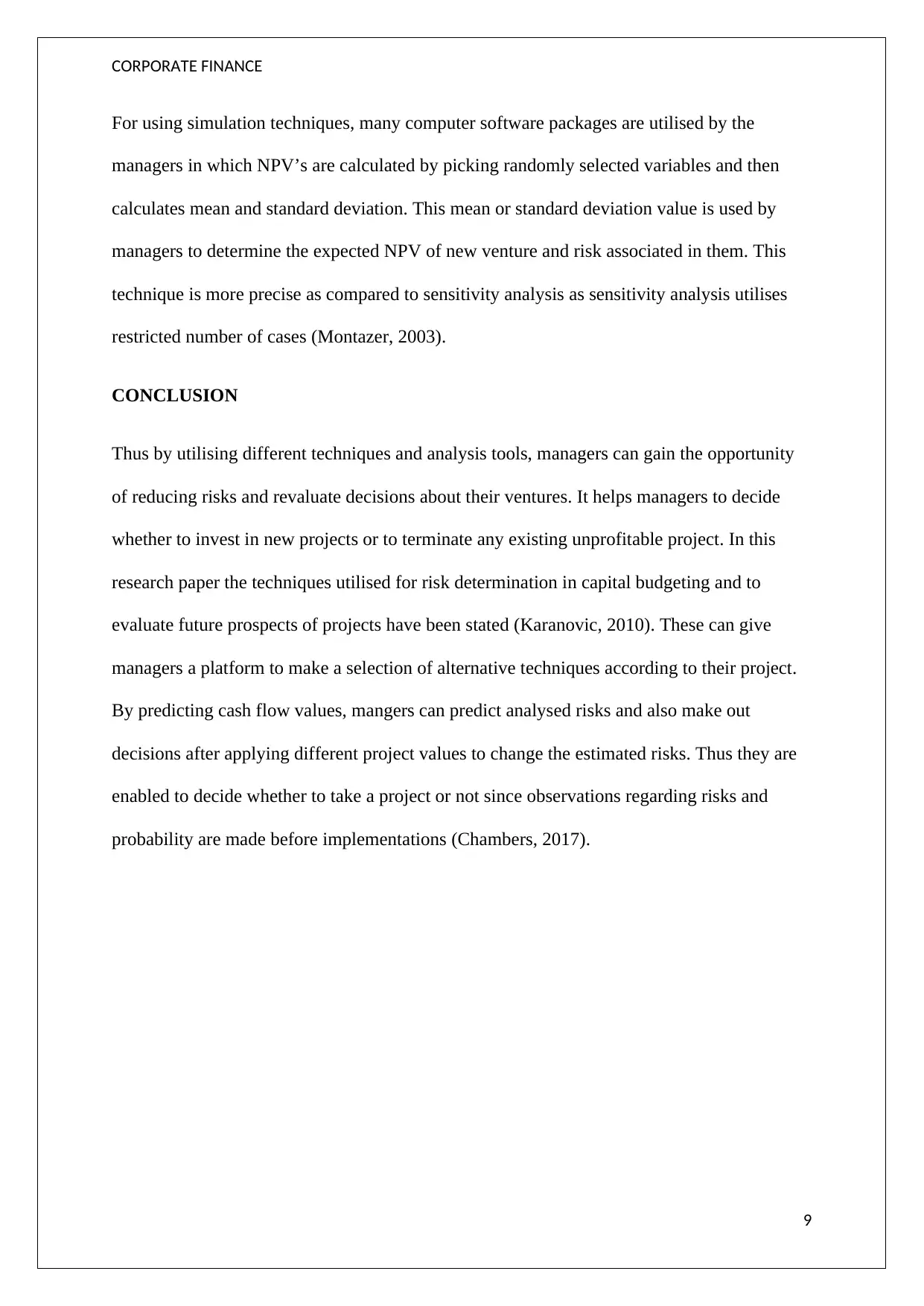
CORPORATE FINANCE
For using simulation techniques, many computer software packages are utilised by the
managers in which NPV’s are calculated by picking randomly selected variables and then
calculates mean and standard deviation. This mean or standard deviation value is used by
managers to determine the expected NPV of new venture and risk associated in them. This
technique is more precise as compared to sensitivity analysis as sensitivity analysis utilises
restricted number of cases (Montazer, 2003).
CONCLUSION
Thus by utilising different techniques and analysis tools, managers can gain the opportunity
of reducing risks and revaluate decisions about their ventures. It helps managers to decide
whether to invest in new projects or to terminate any existing unprofitable project. In this
research paper the techniques utilised for risk determination in capital budgeting and to
evaluate future prospects of projects have been stated (Karanovic, 2010). These can give
managers a platform to make a selection of alternative techniques according to their project.
By predicting cash flow values, mangers can predict analysed risks and also make out
decisions after applying different project values to change the estimated risks. Thus they are
enabled to decide whether to take a project or not since observations regarding risks and
probability are made before implementations (Chambers, 2017).
9
For using simulation techniques, many computer software packages are utilised by the
managers in which NPV’s are calculated by picking randomly selected variables and then
calculates mean and standard deviation. This mean or standard deviation value is used by
managers to determine the expected NPV of new venture and risk associated in them. This
technique is more precise as compared to sensitivity analysis as sensitivity analysis utilises
restricted number of cases (Montazer, 2003).
CONCLUSION
Thus by utilising different techniques and analysis tools, managers can gain the opportunity
of reducing risks and revaluate decisions about their ventures. It helps managers to decide
whether to invest in new projects or to terminate any existing unprofitable project. In this
research paper the techniques utilised for risk determination in capital budgeting and to
evaluate future prospects of projects have been stated (Karanovic, 2010). These can give
managers a platform to make a selection of alternative techniques according to their project.
By predicting cash flow values, mangers can predict analysed risks and also make out
decisions after applying different project values to change the estimated risks. Thus they are
enabled to decide whether to take a project or not since observations regarding risks and
probability are made before implementations (Chambers, 2017).
9
⊘ This is a preview!⊘
Do you want full access?
Subscribe today to unlock all pages.

Trusted by 1+ million students worldwide
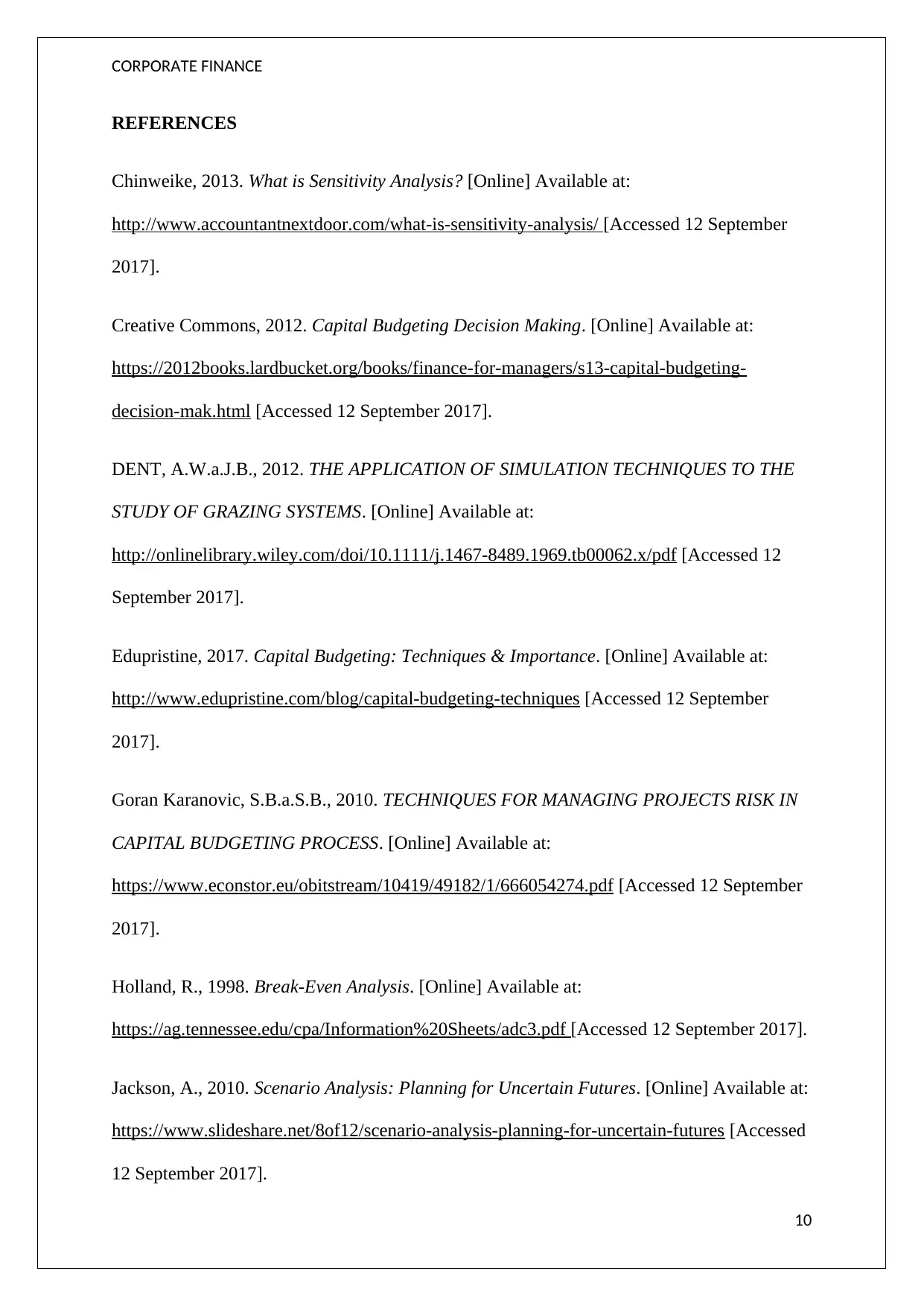
CORPORATE FINANCE
REFERENCES
Chinweike, 2013. What is Sensitivity Analysis? [Online] Available at:
http://www.accountantnextdoor.com/what-is-sensitivity-analysis/ [Accessed 12 September
2017].
Creative Commons, 2012. Capital Budgeting Decision Making. [Online] Available at:
https://2012books.lardbucket.org/books/finance-for-managers/s13-capital-budgeting-
decision-mak.html [Accessed 12 September 2017].
DENT, A.W.a.J.B., 2012. THE APPLICATION OF SIMULATION TECHNIQUES TO THE
STUDY OF GRAZING SYSTEMS. [Online] Available at:
http://onlinelibrary.wiley.com/doi/10.1111/j.1467-8489.1969.tb00062.x/pdf [Accessed 12
September 2017].
Edupristine, 2017. Capital Budgeting: Techniques & Importance. [Online] Available at:
http://www.edupristine.com/blog/capital-budgeting-techniques [Accessed 12 September
2017].
Goran Karanovic, S.B.a.S.B., 2010. TECHNIQUES FOR MANAGING PROJECTS RISK IN
CAPITAL BUDGETING PROCESS. [Online] Available at:
https://www.econstor.eu/obitstream/10419/49182/1/666054274.pdf [Accessed 12 September
2017].
Holland, R., 1998. Break-Even Analysis. [Online] Available at:
https://ag.tennessee.edu/cpa/Information%20Sheets/adc3.pdf [Accessed 12 September 2017].
Jackson, A., 2010. Scenario Analysis: Planning for Uncertain Futures. [Online] Available at:
https://www.slideshare.net/8of12/scenario-analysis-planning-for-uncertain-futures [Accessed
12 September 2017].
10
REFERENCES
Chinweike, 2013. What is Sensitivity Analysis? [Online] Available at:
http://www.accountantnextdoor.com/what-is-sensitivity-analysis/ [Accessed 12 September
2017].
Creative Commons, 2012. Capital Budgeting Decision Making. [Online] Available at:
https://2012books.lardbucket.org/books/finance-for-managers/s13-capital-budgeting-
decision-mak.html [Accessed 12 September 2017].
DENT, A.W.a.J.B., 2012. THE APPLICATION OF SIMULATION TECHNIQUES TO THE
STUDY OF GRAZING SYSTEMS. [Online] Available at:
http://onlinelibrary.wiley.com/doi/10.1111/j.1467-8489.1969.tb00062.x/pdf [Accessed 12
September 2017].
Edupristine, 2017. Capital Budgeting: Techniques & Importance. [Online] Available at:
http://www.edupristine.com/blog/capital-budgeting-techniques [Accessed 12 September
2017].
Goran Karanovic, S.B.a.S.B., 2010. TECHNIQUES FOR MANAGING PROJECTS RISK IN
CAPITAL BUDGETING PROCESS. [Online] Available at:
https://www.econstor.eu/obitstream/10419/49182/1/666054274.pdf [Accessed 12 September
2017].
Holland, R., 1998. Break-Even Analysis. [Online] Available at:
https://ag.tennessee.edu/cpa/Information%20Sheets/adc3.pdf [Accessed 12 September 2017].
Jackson, A., 2010. Scenario Analysis: Planning for Uncertain Futures. [Online] Available at:
https://www.slideshare.net/8of12/scenario-analysis-planning-for-uncertain-futures [Accessed
12 September 2017].
10
Paraphrase This Document
Need a fresh take? Get an instant paraphrase of this document with our AI Paraphraser
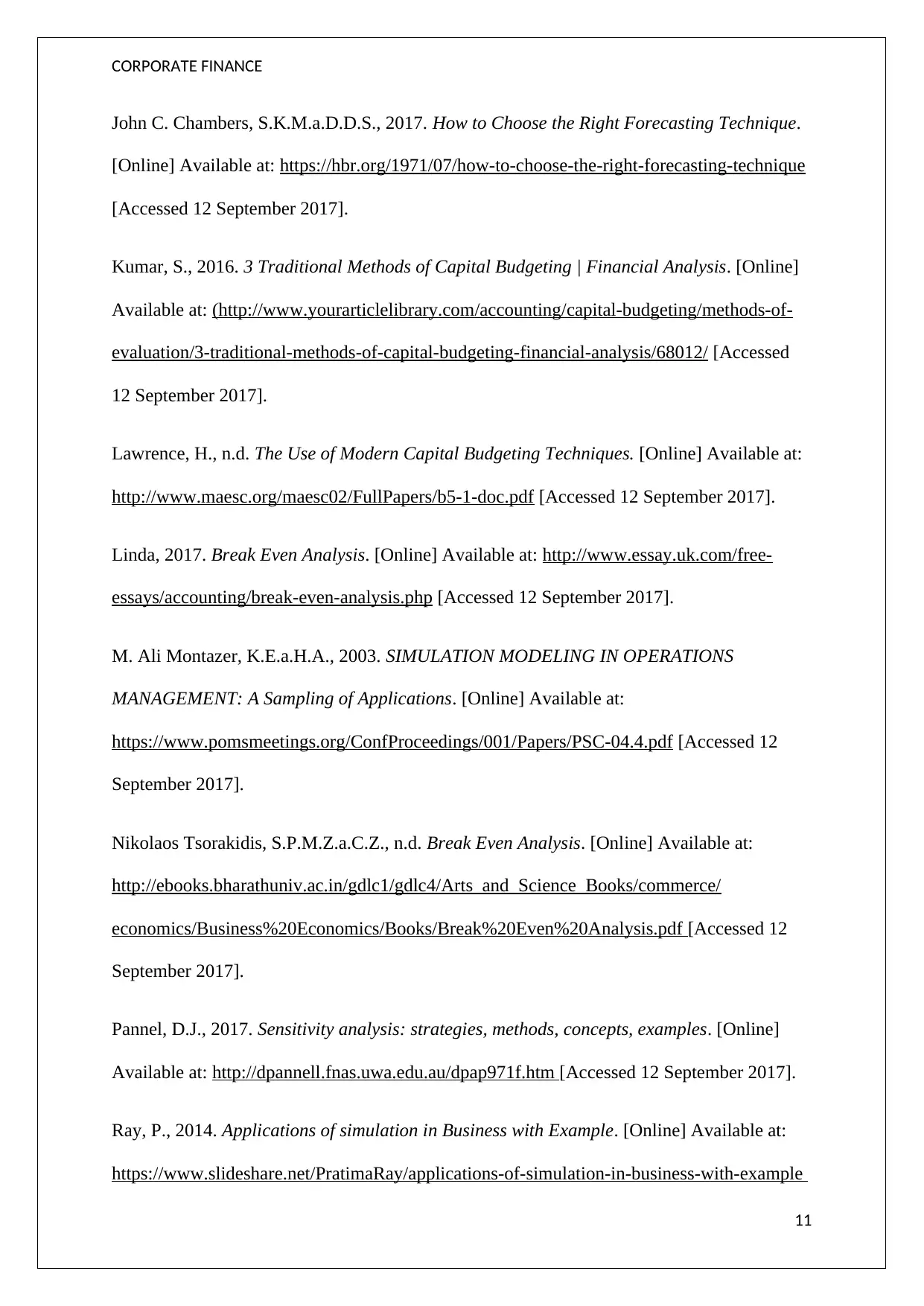
CORPORATE FINANCE
John C. Chambers, S.K.M.a.D.D.S., 2017. How to Choose the Right Forecasting Technique.
[Online] Available at: https://hbr.org/1971/07/how-to-choose-the-right-forecasting-technique
[Accessed 12 September 2017].
Kumar, S., 2016. 3 Traditional Methods of Capital Budgeting | Financial Analysis. [Online]
Available at: (http://www.yourarticlelibrary.com/accounting/capital-budgeting/methods-of-
evaluation/3-traditional-methods-of-capital-budgeting-financial-analysis/68012/ [Accessed
12 September 2017].
Lawrence, H., n.d. The Use of Modern Capital Budgeting Techniques. [Online] Available at:
http://www.maesc.org/maesc02/FullPapers/b5-1-doc.pdf [Accessed 12 September 2017].
Linda, 2017. Break Even Analysis. [Online] Available at: http://www.essay.uk.com/free-
essays/accounting/break-even-analysis.php [Accessed 12 September 2017].
M. Ali Montazer, K.E.a.H.A., 2003. SIMULATION MODELING IN OPERATIONS
MANAGEMENT: A Sampling of Applications. [Online] Available at:
https://www.pomsmeetings.org/ConfProceedings/001/Papers/PSC-04.4.pdf [Accessed 12
September 2017].
Nikolaos Tsorakidis, S.P.M.Z.a.C.Z., n.d. Break Even Analysis. [Online] Available at:
http://ebooks.bharathuniv.ac.in/gdlc1/gdlc4/Arts_and_Science_Books/commerce/
economics/Business%20Economics/Books/Break%20Even%20Analysis.pdf [Accessed 12
September 2017].
Pannel, D.J., 2017. Sensitivity analysis: strategies, methods, concepts, examples. [Online]
Available at: http://dpannell.fnas.uwa.edu.au/dpap971f.htm [Accessed 12 September 2017].
Ray, P., 2014. Applications of simulation in Business with Example. [Online] Available at:
https://www.slideshare.net/PratimaRay/applications-of-simulation-in-business-with-example
11
John C. Chambers, S.K.M.a.D.D.S., 2017. How to Choose the Right Forecasting Technique.
[Online] Available at: https://hbr.org/1971/07/how-to-choose-the-right-forecasting-technique
[Accessed 12 September 2017].
Kumar, S., 2016. 3 Traditional Methods of Capital Budgeting | Financial Analysis. [Online]
Available at: (http://www.yourarticlelibrary.com/accounting/capital-budgeting/methods-of-
evaluation/3-traditional-methods-of-capital-budgeting-financial-analysis/68012/ [Accessed
12 September 2017].
Lawrence, H., n.d. The Use of Modern Capital Budgeting Techniques. [Online] Available at:
http://www.maesc.org/maesc02/FullPapers/b5-1-doc.pdf [Accessed 12 September 2017].
Linda, 2017. Break Even Analysis. [Online] Available at: http://www.essay.uk.com/free-
essays/accounting/break-even-analysis.php [Accessed 12 September 2017].
M. Ali Montazer, K.E.a.H.A., 2003. SIMULATION MODELING IN OPERATIONS
MANAGEMENT: A Sampling of Applications. [Online] Available at:
https://www.pomsmeetings.org/ConfProceedings/001/Papers/PSC-04.4.pdf [Accessed 12
September 2017].
Nikolaos Tsorakidis, S.P.M.Z.a.C.Z., n.d. Break Even Analysis. [Online] Available at:
http://ebooks.bharathuniv.ac.in/gdlc1/gdlc4/Arts_and_Science_Books/commerce/
economics/Business%20Economics/Books/Break%20Even%20Analysis.pdf [Accessed 12
September 2017].
Pannel, D.J., 2017. Sensitivity analysis: strategies, methods, concepts, examples. [Online]
Available at: http://dpannell.fnas.uwa.edu.au/dpap971f.htm [Accessed 12 September 2017].
Ray, P., 2014. Applications of simulation in Business with Example. [Online] Available at:
https://www.slideshare.net/PratimaRay/applications-of-simulation-in-business-with-example
11
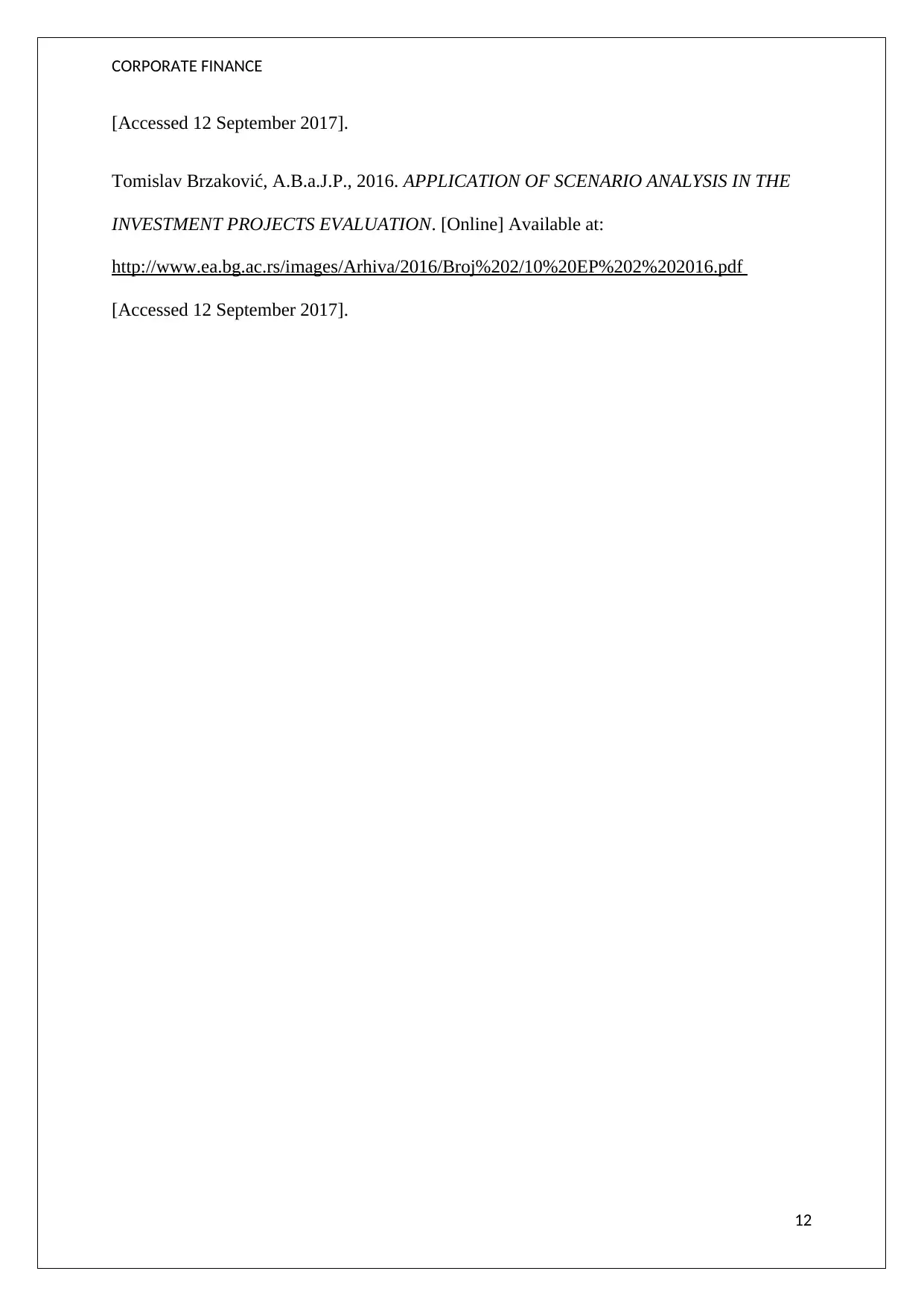
CORPORATE FINANCE
[Accessed 12 September 2017].
Tomislav Brzaković, A.B.a.J.P., 2016. APPLICATION OF SCENARIO ANALYSIS IN THE
INVESTMENT PROJECTS EVALUATION. [Online] Available at:
http://www.ea.bg.ac.rs/images/Arhiva/2016/Broj%202/10%20EP%202%202016.pdf
[Accessed 12 September 2017].
12
[Accessed 12 September 2017].
Tomislav Brzaković, A.B.a.J.P., 2016. APPLICATION OF SCENARIO ANALYSIS IN THE
INVESTMENT PROJECTS EVALUATION. [Online] Available at:
http://www.ea.bg.ac.rs/images/Arhiva/2016/Broj%202/10%20EP%202%202016.pdf
[Accessed 12 September 2017].
12
⊘ This is a preview!⊘
Do you want full access?
Subscribe today to unlock all pages.

Trusted by 1+ million students worldwide
1 out of 12
Related Documents
Your All-in-One AI-Powered Toolkit for Academic Success.
+13062052269
info@desklib.com
Available 24*7 on WhatsApp / Email
![[object Object]](/_next/static/media/star-bottom.7253800d.svg)
Unlock your academic potential
Copyright © 2020–2025 A2Z Services. All Rights Reserved. Developed and managed by ZUCOL.





